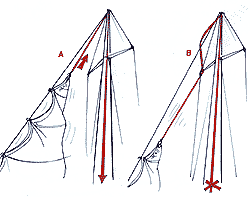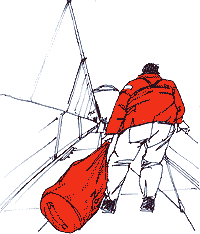HOISTING

1. The bow man checks the hanks, sheets and halyard, gets to weather and signals it's OK to hoist.
2. The crew on the halyard LOOKS UP (A) and checks the halyard is not twisted around the forestay or fouling the spreaders (B).
3. If it is clear, the halyard is hauled in smartly either by pulling directly or by taking a turn-around the halyard winch (C).


4. Take several turns around the winch and use the winch handle to tension the luff of the sail. (Luff tension is right when horizontal luff creases disappear but vertical creases are not formed when the sail is sheeted in.) Coil and cleat the halyard (see page 35).
CHANGING HElDSAILS

| 
|
| 1. Drag the bagged sail along the windward sidedeck and make sure you are hooked on in heavy weather. | 2. Hank on the new sail (starting at the tack) below the first hank of the old sail. Secure the bag. |

| 3. Tension is kept on the halyard by letting it slip around the winch as the sail is pulled down. |

| 
|
| 4. Pull on the luff of the old sail to lower it. Remove the halyard and secure it. Transfer the sheets to the new sail. | 5. Bag or stow the old sail and unhunk. Transfer the halyard to the new sail and hoist when ready. |
HEADFOILS
Insert half a metre before hoisting

| Some boats have headsails which run up grooves in a HEADFOIL. This makes for very quick sail changes especially when racing. Sails can often be kept in their special bag while the tack (I) and sheets are attached. The bolt rope (2) is fed through the pre-feeder CD and into the foil (4). The halyard (5) is fixed on. The sail tie (6) and bag are removed ready for hoisting. The new sail can be hoisted inside or outside the old one and if the halyards and sheets are right, a fast TACK CHANGE can be made. | |

|

Flake the old sail down on deck and secure it with a sail tie. Fold it like this so the TACK (1), HEAD (2) and CLEW (U) are readily accessible in the bag. Bags vary in design, but usually have a full length zip which can sometimes just be pulled apart. ALWAYS TIE THE BAG TO THE BOAT.
| BENDING ON THE MAINSAIL 1. The CLEW is fed into the groove in the boom. 2. The TACK is fixed to the gooseneck and the foot of the sail tcnsioned at the clew. 3. BATTENS are slid into their pockets. 4. The LUFF SLIDES ure fed into the groove in the mast via a mast gate and the gate closed. | 
|
| SAIL COVERS The bent-on sail is usually protected by a sail cover which can be fastened in a variety of ways. It's removed by rolling or flaking like this. | 
|
| SAIL TIES The furled sail is secured by a number of SAIL TIES. These can be made of rope, tape or elastic. The ties can be secured in a number of ways, but a simple bow is as good as any. Ask the skipper how he wants them secured but be very careful of elastic as it can sometimes hit you in the eye. | 
|
Дата добавления: 2015-07-24; просмотров: 807;
